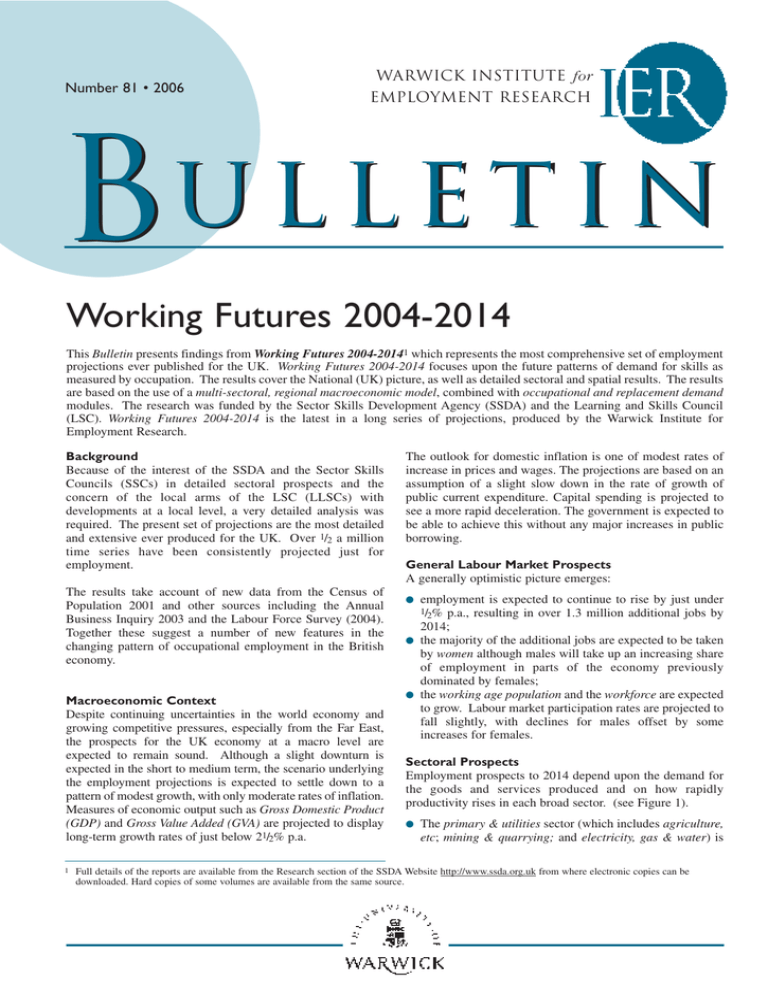B U L L E T I N Working Futures 2004-2014
advertisement

Number 81 • 2006 WARWICK INSTITUTE for EMPLOYMENT RESEARCH BU L L E T I N Working Futures 2004-2014 This Bulletin presents findings from Working Futures 2004-20141 which represents the most comprehensive set of employment projections ever published for the UK. Working Futures 2004-2014 focuses upon the future patterns of demand for skills as measured by occupation. The results cover the National (UK) picture, as well as detailed sectoral and spatial results. The results are based on the use of a multi-sectoral, regional macroeconomic model, combined with occupational and replacement demand modules. The research was funded by the Sector Skills Development Agency (SSDA) and the Learning and Skills Council (LSC). Working Futures 2004-2014 is the latest in a long series of projections, produced by the Warwick Institute for Employment Research. Background Because of the interest of the SSDA and the Sector Skills Councils (SSCs) in detailed sectoral prospects and the concern of the local arms of the LSC (LLSCs) with developments at a local level, a very detailed analysis was required. The present set of projections are the most detailed and extensive ever produced for the UK. Over 1/2 a million time series have been consistently projected just for employment. The results take account of new data from the Census of Population 2001 and other sources including the Annual Business Inquiry 2003 and the Labour Force Survey (2004). Together these suggest a number of new features in the changing pattern of occupational employment in the British economy. Macroeconomic Context Despite continuing uncertainties in the world economy and growing competitive pressures, especially from the Far East, the prospects for the UK economy at a macro level are expected to remain sound. Although a slight downturn is expected in the short to medium term, the scenario underlying the employment projections is expected to settle down to a pattern of modest growth, with only moderate rates of inflation. Measures of economic output such as Gross Domestic Product (GDP) and Gross Value Added (GVA) are projected to display long-term growth rates of just below 21/2% p.a. 1 The outlook for domestic inflation is one of modest rates of increase in prices and wages. The projections are based on an assumption of a slight slow down in the rate of growth of public current expenditure. Capital spending is projected to see a more rapid deceleration. The government is expected to be able to achieve this without any major increases in public borrowing. General Labour Market Prospects A generally optimistic picture emerges: ● employment is expected to continue to rise by just under p.a., resulting in over 1.3 million additional jobs by 2014; the majority of the additional jobs are expected to be taken by women although males will take up an increasing share of employment in parts of the economy previously dominated by females; the working age population and the workforce are expected to grow. Labour market participation rates are projected to fall slightly, with declines for males offset by some increases for females. 1/2% ● ● Sectoral Prospects Employment prospects to 2014 depend upon the demand for the goods and services produced and on how rapidly productivity rises in each broad sector. (see Figure 1). ● The primary & utilities sector (which includes agriculture, etc; mining & quarrying; and electricity, gas & water) is Full details of the reports are available from the Research section of the SSDA Website http://www.ssda.org.uk from where electronic copies can be downloaded. Hard copies of some volumes are available from the same source. 2 ● ● ● ● ● expected to continue to experience job losses in the next decade (just under 100,000 jobs in total); Long-term decline in employment in manufacturing is expected to continue, with a loss of just under 400,000 jobs between 2004 and 2014. Textiles & clothing displays the largest losses (75,000 jobs), but there are significant declines elsewhere; Construction is projected to experience a slight fall in the total level of employment of just under 100,000 between 2004 and 2014; Employment in distribution, transport etc, is expected to increase by around 500,000 jobs between 2004 and 2014, with most of the growth in distribution and retailing; Employment in business & other services is forecast to increase by just under a million by 2014, with other business services (including computing services) showing the fastest growth; Employment in non-marketed services, is expected to increase by around 400,000 between 2004 and 2014. Most of the projected employment growth is accounted for by education and health & social work; public administration & defence employment is forecast to fall. Changes in Occupational Structure The results suggest some significant changes in occupational prospects for the next ten years (see Figure 2). In general these patterns are similar to those in Working Futures 20022012. The groups that are expected to show significant increases in employment over the next decade (2004-2014) are higher level occupations such as: ● ● ● managers & senior officials (+617,000); professional occupations (+697,000); associate professional & technical occupations (+238,000). Sales & customer service occupations and personal service occupations are the other main beneficiaries of employment growth, (with projected increases of 424,000 and 375,000 respectively). Administrative, clerical & secretarial occupations are expected to see further job losses of around 164,000 jobs, although this category will continue to employ over 31/2 million people. Declining employment levels are projected for: ● ● ● skilled trades occupations (-150,000); machine & transport operatives (some -118,000); and elementary occupations (-675,000). Amongst these declining groups, it is the elementary occupations which are expected to see by far the largest absolute reduction in numbers. These projections focus on the net growth (or decline) in occupational employment. Such estimates provide a useful indication of likely ‘gainers’ and ‘losers’ from employment change. This has traditionally been referred to as expansion demand, although for some occupations it can be negative. However, employers will often need to replace those workers who leave – due to mortality, retirement, career moves, or related reasons. Such replacement demand can easily outweigh losses due to structural changes. For all occupations together, replacement demand is about 8 times larger than the net changes projected between 2004 and 2014. Over the decade there is expected to be a net requirement of about 12 million job openings. Retirements are the principal component in this estimate. This excludes job openings created by people moving from one occupation to another or other outflows. How Reliable are the Projections? It is important to appreciate that the purpose of the Working Futures 2004-2014 projections is not to make precise forecasts of employment levels. Rather, the aim is to provide policy analysts and others interested in future trends in the 3 countries within the UK (Wales, Scotland and Northern Ireland). Figure 3 provides illustrative results for London. Analogous information is available for all the countries and regions of the UK. Results are also produced at a more detailed local LSC level. The projected changes in output and employment prospects can be seen as a combination of a number of general trends, common across all geographical areas, together with the specific structural features of each area. The trends common to almost all regions are: ● structure and composition of employment in the UK with useful information about the general nature of changing employment patterns and their implications for skill requirements. All of the Working Futures 2004-2014 projections should therefore be regarded as indicative, rather than being precise predictions of the magnitude of any changes. Indeed, the focus on industrial and spatial disaggregation at the level of detail provided in Working Futures 2004-2014 pushes the available data to the limits for which it was originally collected. Detailed Sectoral Results The separate Sectoral Report (Green et al., 2006) summarises the new projections by the Skills for Business’ network of employer-led Sector Skills Councils. A total of 24 SSCs have already been licensed and others are ‘in development’. The remaining industrial sectors are the responsibility of the SSDA, and projections for these are grouped according to their primary industrial activity. For the first time, estimates are presented of total employment in each of the SSCs, disaggregated by gender and employment status, together with some comparative analysis of their relative size and structure, and the anticipated changes over the period 20042014. This includes a detailed description of the scope and sectoral coverage of each SSC. Details for Individual Countries and Regions The Spatial Report focuses on changes within the UK and provides the most comprehensive picture available on future patterns of the demand for and supply of skills, focussing upon occupations. The term ‘region’ is used as a shorthand to cover all the English regions (as represented by the Regional Development Agencies in England), as well as the other ● ● Sectoral shifts in favour of employment in the service sector, especially marketed services related to business and tourism and leisure; ● Significant further job losses in the primary and manufacturing sectors; ● Linked to these developments are some changes in favour of part-time working and an increasing role for female workers in the formal economy; ● Changing occupational structures in favour of higher level, white collar jobs such as managerial, professional and associate professional occupations; ● Increasing employment shares also for personal service and sales & customer service occupations; Job losses for many administrative, clerical & secretarial occupations; Employment decline for most blue collar, manual occupations, including many skilled trades; machine & transport operatives and elementary occupations. Each of the English regions and the other countries of the UK possess unique structural features which serve to moderate or reinforce these general trends. In general, the trends outlined are deep-seated and persistent. Key features of change include: ● ● ● The three regions of south-eastern England, London, the South East and the East of England, emerge as the fastest growing, in terms of employment and output. They are characterised by greater than average shares of employment in high level non-manual occupations. Together, the whole of London and most of the South East and East of England regions may be thought of as a London-dominated “mega-city-region”. The South West is expected to experience employment and output growth at rates similar to the UK average. In this region part-time employees and the self-employed account for larger than average shares of total employment. The East Midlands and West Midlands have the largest shares of employment in manufacturing and are projected to experience some of the fastest rates of job loss over the period to 2014. However, an increase in employment in services is expected: the West Midlands has the fastest projected increase in non-marketed services in the UK over the period to 2014. These two regions display the fastest projected rates of job loss in skilled trades occupations and elementary occupations over the medium-term. 4 ● ● ● ● Yorkshire & the Humber is projected to experience employment growth at the same rate as the UK over the period to 2014, but projected output growth is slower than average. The region is characterised by smaller than average shares of employment in professional and associate professional occupations and projected growth is slower than average. Contrary to the UK trend, a modest increase in employment for administrative, clerical & secretarial occupations is projected In the North West projected output and employment growth are slower than the UK average. This is apparent in all service sectors and in all occupations where employment growth is expected with the exception of personal service occupations. In Wales employment is projected to grow at the same rate as the UK average over the period to 2014, but projected output growth is slower than average. Non-marketed services are projected to continue to account for a much larger share of total employment in Wales than across the UK as a whole. Projected employment growth for females is confined to parttime employees and Wales displays the fastest rate of projected growth for male part-time employees. Northern Ireland displays slightly more modest employment and output growth than the UK average. A loss in male full-time employees is expected, but projected growth rates for male part-time employees and for female employees exceed the UK average. ● Scotland and the North East display the slowest projected output growth and employment growth of any part of the UK over the period to 2014. References Dickerson, A., K. Homenidou and R.A. Wilson, (2006), Working Futures 2004-2014: Sectoral Report. Sector Skills Development Agency: Wath on Dearne. Green A., K. Homenidou, R. White and R.A. Wilson, (2006), Working Futures 2004-2014: Spatial Report. Sector Skills Development Agency: Wath on Dearne. Wilson, R.A,., K. Homenidou and A.P. Dickerson, (2006), Working Futures 2004-2014: Technical Report. Sector Skills Development Agency: Wath on Dearne. For further details of IER’s forecasting work contact: Rob Wilson, Institute for Employment Research, University of Warwick, Coventry CV4 7AL, UK, Tel +44 (0) 24 7652 3530 Fax +44 (0) 24 7652 4241, E-mail r.a.wilson@warwick.ac.uk or visit www.warwick.ac.uk/ier. In 2006/07 IER will celebrate its 25th anniversary. A series of events, including thematic seminars and conferences, are planned. Further details will be advertised shortly.





